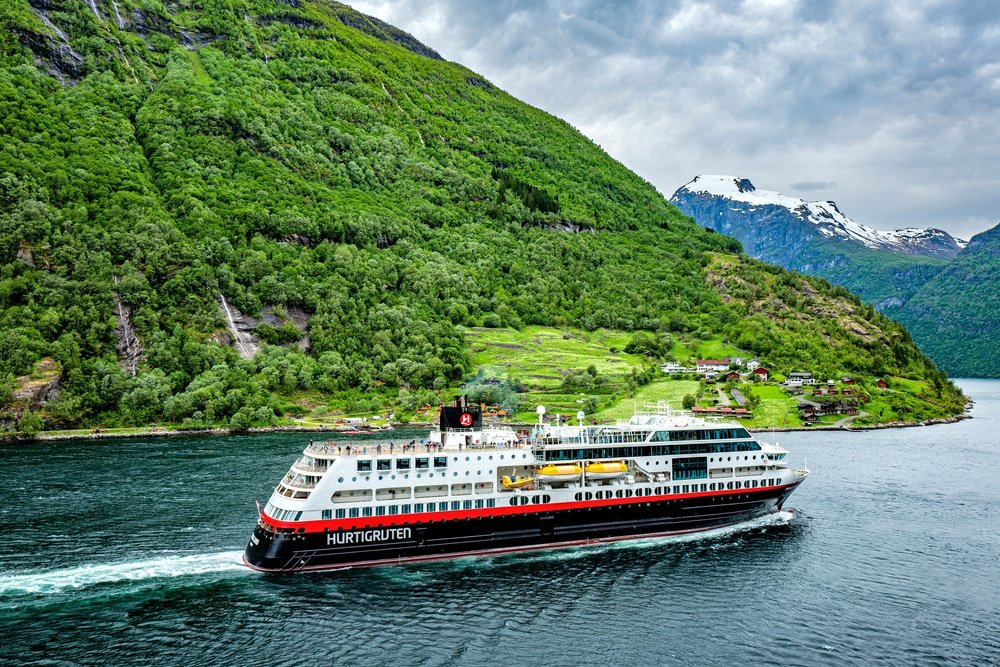In a world increasingly conscious of its carbon footprint, one company is making waves. Hurtigruten, a Norwegian cruise line, is charting a course towards a greener future with plans to launch the world’s first zero-emission cruise ship by 2030.
This ambitious project, aptly named “Sea Zero,” is a beacon of innovation in sustainable maritime travel. This world’s most energy-efficient and first zero-emission cruise ship was first floated in March 2022.
Hurtigruten partnered with 12 industry leaders and research institute SINTEF to bring this dream green tech to a reality.
The Power of Renewable Energy
At the heart of this groundbreaking vessel is its power source. Unlike traditional cruise ships that rely on fossil fuels, Hurtigruten’s new ship will be powered by a 60 MWh battery pack.
This battery will be charged in port with clean energy, reflecting Norway’s commitment to renewable power sources. Renewables account for 98% of Norway’s electricity system.
With a range of 300 to 350 nautical miles per charge, the ship will need to recharge seven or eight times during an 11-day round trip.
But that’s just the start of Hurtigruten zero-emission cruise ship’s innovative design.
Solar Sails: Harnessing the Power of the Sun and Wind
In a novel approach to energy efficiency, the ship will feature three retractable sails. But these aren’t your average sails.
They’re covered in solar panels, effectively turning the ship into a floating solar farm. These sails can adjust to catch the most wind and shrink to pass under bridges.
The three autonomous wing rigs will feature 1,500 square meters (16,000 sqft) of solar panels and a combined wind surface of 750 square meters (8,000 sqft). When fully extended, they will reach a height of 50m (164 ft).
This will generate additional energy to top up the batteries while sailing, reducing the need for charging and further decreasing the ship’s carbon footprint.
The battery levels will be displayed on the external side of the ship for monitoring.
Zero-Emission Cruise Ship: A Design for the Future
The ship’s design is also geared towards sustainability. With 270 cabins for 500 guests and 99 crew, its streamlined shape reduces air resistance, further conserving energy.
An interactive mobile app will allow guests to monitor and minimize their personal water and energy consumption, making them active participants in the ship’s sustainability journey.
This focus on individual responsibility reflects a growing recognition that tackling climate change requires collective action.
Hurtigruten’s CEO, Hedda Felin, is clear about the company’s commitment. They aim to deliver a ship that “surpasses all others in terms of energy efficiency and sustainability” within a few years.
The hope is that this initiative will inspire the entire maritime industry to accelerate its sustainability efforts. With the shipping industry accounting for around 3% of global manmade greenhouse gas emissions, according to the International Maritime Organization, the potential impact of such a shift is significant.
Meanwhile, other cruise liners are also exploring designs for eco-friendly sailing vessels. Take for instance, the case of the transatlantic car carrier Oceanbird and other cargo ships with retractable or folding solid sails. But they still rely on fossil fuel engines to run.
Hurtigruten Norway noted that while its design will still have a backup engine for safety reasons, it will run off green fuels like ammonia or biofuel.
Plus, other advanced technologies will also be on-board such as artificial intelligence maneuvering, contra-rotating propellers, and multiple retractable thrusters. Air lubrication, advanced hull coating, and proactive hull cleaning will further enable Sea Zero to sail efficiently and emission-free.
The Road Ahead: Testing and Production
Over the next two years, Hurtigruten will test the proposed technologies before finalizing the design in 2026. Shipyard production will begin in 2027, with the first vessel sailing Norwegian waters in 2030.
The ultimate goal? Transforming its entire fleet into zero-emission vessels.
Right now, only 0.1% of ships worldwide is using zero-emission technology.
Hurtigruten’s commitment to sustainability is not just about reducing its own carbon emissions. It’s also about demonstrating what’s possible and offering a model that other companies can follow.
Hurtigruten is leading one of the largest environmental upgrades in European maritime history. And it’s not the first time the company has revealed its sustainable shipping solution. It launched the world’s first hybrid battery-supported adventure cruise ship 4 years ago.
Two ships have been upgraded to battery-hybrid power, with a third planned for this fall. The remaining 5 vessels are being equipped with technologies that will reduce CO² emissions by 25% and NOx by 80%.
Hurtigruten’s zero-emission cruise ship is a testament to the potential of renewable energy in transforming industries. It’s a bold vision of a future where sustainability is not just an aspiration.


